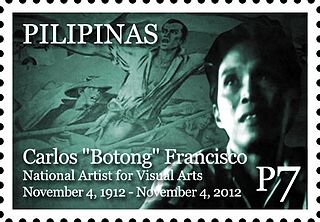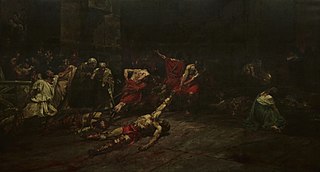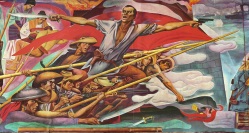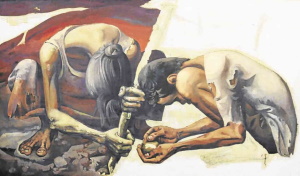
The Philippine General Hospital, simply referred to as UP–PGH or PGH, is a tertiary state-owned hospital administered and operated by the University of the Philippines Manila. It is designated as the National University Hospital, and the national government referral center. It stands within a 10-hectare (25-acre) site located at the UP Manila Campus in Ermita, Manila. PGH has 1,100 beds and 400 private beds, and has an estimated of 4,000 employees to serve more than 600,000 patients every year.

The University of the Philippines Manila is a public, coeducational, research university located in Ermita, Manila, Philippines. It is known for being the country's center of excellence in the health sciences, including health professional education, training, and research. It is the oldest of eight constituent universities of the University of the Philippines System, and predates the founding of UP by three years. It was originally established on December 1, 1905, as the Philippine Medical School and later renamed as the UP College of Medicine and Surgery on June 10, 1907. In 1983 it was renamed as University of the Philippines Manila.

Carlos Modesto "Botong" Villaluz Francisco was a Filipino muralist from Angono, Rizal.

The Spoliarium is a painting by Filipino painter Juan Luna. Luna, working on canvas, spent eight months completing the painting which depicts dying gladiators. The painting was submitted by Luna to the Exposición Nacional de Bellas Artes in 1884 in Madrid, where it garnered the first gold medal. The picture recreates a despoiling scene in a Roman circus where dead gladiators are stripped of weapons and garments. Together with other works of the Spanish Academy, the Spoliarium was on exhibit in Rome in April 1884.

Far Eastern University, also referred to by its acronym FEU, is a private research non-sectarian university in Manila, Philippines. Created by the merger of Far Eastern College and the Institute of Accounts, Business and Finance, FEU became a university in 1934 during the term of its first president, Nicanor Reyes Sr.

The National Museum of Fine Arts, formerly known as the National Art Gallery, is an art museum in Manila, Philippines. It is located on Padre Burgos Avenue across from the National Museum of Anthropology in the eastern side of Rizal Park. The museum, owned and operated by the National Museum of the Philippines, was founded in 1998 and houses a collection of paintings and sculptures by classical Filipino artists such as Juan Luna, Félix Resurrección Hidalgo and Guillermo Tolentino.

The Santa Monica Parish Church, commonly known as the Minalin Church, is a Baroque Roman Catholic church, located in poblacion area of San Nicolas in Minalin, Pampanga, Philippines. The church, built during the Spanish era, was declared a National Cultural Treasure by the National Commission for Culture and the Arts and the National Museum of the Philippines on August 27, 2011, one of 37 churches in the country bestowed that honor.

The history of medicine in the Philippines discusses the folk medicinal practices and the medical applications used in Philippine society from the prehistoric times before the Spaniards were able to set a firm foothold on the islands of the Philippines for over 300 years, to the transition from Spanish rule to fifty-year American colonial embrace of the Philippines, and up to the establishment of the Philippine Republic of the present. Although according to Dr. José Policarpio Bantug in his book A Short History of Medicine in the Philippines During The Spanish Regime, 1565-1898 there were "no authentic monuments have come down to us that indicate with some certainty early medical practices" regarding the "beginnings of medicine in the Philippines" a historian from the United States named Edward Gaylord Borne described that the Philippines became "ahead of all the other European colonies" in providing healthcare to ill and invalid people during the start of the 17th century, a time period when the Philippines was a colony of Spain. From the 17th and 18th centuries, there had been a "state-of-the-art medical and pharmaceutical science" developed by Spanish friars based on Filipino curanderos that was "unique to the [Philippine] islands."

The history of veterinary medicine in the Philippines discusses the history of veterinary medicine as a profession in the Philippines. Its history in the Philippines began in 1828, while the Philippines was still a colony of Spain, progressing further during the time when the Philippines became a territory of the United States, until the establishment of the Philippines as an independent Republic in the modern-day era.

The history of physical therapy in the Philippines relates how physical therapy started in the Philippines and how it evolved as a profession through three significant phases in the history of the Philippines: from the American era leading to the Japanese occupation of the islands during World War II, and up to the modern-day time period of the independent Philippine Republics. It was introduced in the Philippines ahead of rehabilitation medicine.

The National Shrine of Our Lady of the Abandoned, also known as the Santa Ana Church, is a Spanish colonial period church located in the district of Santa Ana in Manila, Philippines. The parish was established by the Franciscan missionaries in 1578 under the patronage of Saint Anne. The present stone church was constructed by Vicente Inglés from 1720 to 1725 and was dedicated to its present patron, the Our Lady of the Abandoned. The revered image of its patron was made in Valencia, Spain in 1713 and arrived in the Philippines in 1717.

The Philippine Institute of Architects (PIA) is an architectural society in the Philippines and is the oldest architectural society in Asia. It is composed of noble men and women from the architectural profession of the Philippines. It was founded by renowned architects in 1933 whose ultimate endeavor is the professional development of architecture in the Philippines.

Nemesio “Nemi” R. Miranda Jr., also known as Nemiranda, is a Filipino painter and sculptor in Angono, Rizal. He gained fame as the forerunner the art form “Imaginative Figurism”. He has a degree in Bachelor of Fine Arts from University of Santo Tomas, Manila, Philippines. He is the father of modern artist Keiye Miranda.
Galo B. Ocampo was a Philippine artist. He was also the first Filipino to study heraldry and was a member of the International Institute of Genealogy and Heraldry in Madrid.

Helen Katharine Forbes was a Californian artist and arts educator specializing in etching, murals and painting. She is best known for western landscapes, portrait paintings, and her murals with the Treasury Section of Fine Arts and Work Progress Administration (WPA). Forbes was skilled in painting in oil, watercolor, and egg tempera. She painted landscapes of Mexico, Mono Lake and the Sierras in the 1920s, desert scenes of Death Valley in the 1930s, and portraits and still-lifes.

The Tanghalang Pambansa, formerly Theater of Performing Arts, is a theater located in the Cultural Center of the Philippines Complex in Manila, Philippines.

The Filipino Struggles Through History is an artwork by Filipino artist Botong Francisco. The artwork is a declared National Cultural Treasure.

Patrick Duarte Flores (Iloilo,1969) is a Filipino curator, critic, and professor. Born in the Philippines, he received degrees in humanities, art history, and Philippine studies at the University of the Philippines Diliman. He is a professor of Art Studies in the Department of Art Studies at the University of the Philippines and curator of the Vargas Museum in Manila. He was also a curator of the Arts Division, Philippine National Museum and curator of the Philippine Pavilion at the Venice Biennale in 2015. He was the artistic director of the 2019 Singapore Biennale.

In 1941, Anton Refregier won the $26,000 commission for the series History of San Francisco, which are a set of 27 murals painted in the lobby of the Rincon Annex Post Office in San Francisco, California. Refregier painted the mural with casein tempera on white gesso over plaster walls, in the social realism style. Work was interrupted by World War II and restarted in 1946; the murals were completed in 1948.

Camote Diggers is an unfinished painting and considered as the last artwork by Philippine National Artist Botong Francisco prior to his death in 1969.



















